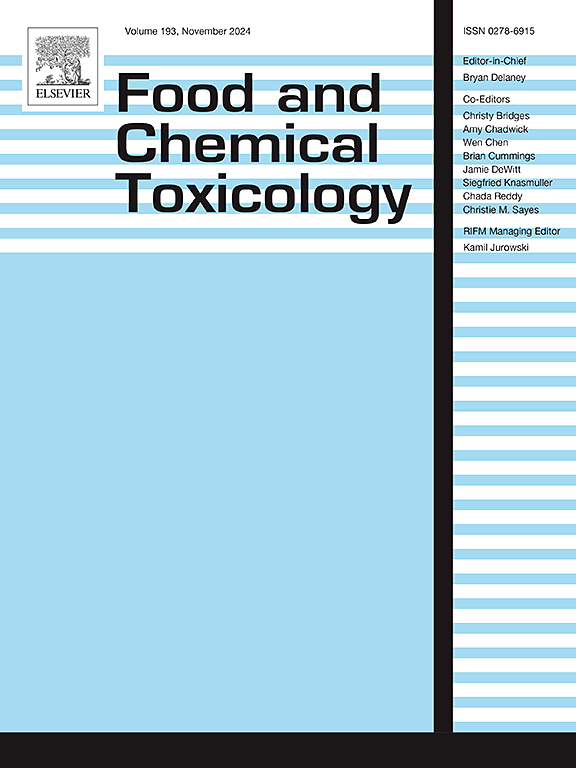全氟己烷磺酸(PFHxS)通过激活自噬和内质网应激调节的线粒体通路凋亡诱导肝细胞毒性
IF 3.5
3区 医学
Q2 FOOD SCIENCE & TECHNOLOGY
引用次数: 0
摘要
全氟己烷磺酸(PFHxS)是全氟烷磺酸的常见替代品,广泛用于各种工业产品。随着PFHxS污染变得越来越普遍,在人类脐带血、血清和母乳等样本中发现了PFHxS。在人类中,PFHxS的消除半衰期至少为8.5年。虽然PFHxS在肝脏中显示出最高的组织-血浆分配系数,并且已知会导致肝脏肥大,但PFHxS诱导肝毒性的机制尚不清楚。本研究通过检测细胞活力、凋亡率、活性氧(ROS)水平、Ca2+水平和蛋白表达来评估PFHxS对人肝脏L02细胞的影响。结果表明,暴露于浓度为80 ~ 320 μM的PFHxS 24 h,特别是320 μM的PFHxS,可引发自噬和内质网应激(ERS)调节的线粒体通路凋亡。其特征是ROS和Ca2+水平升高,以及LC3B-II、ATG3、ATG5、ATG7、p-Beclin-1、p62、ATF6、GRP78、CHOP、Bax、CYPD和Cyt-C等蛋白的上调。相反,Sigma-1受体(Sig-1R)、p-mTOR和Bcl-2的蛋白表达被抑制。综上所述,PFHxS通过激活自噬和ers调控的线粒体通路凋亡诱导肝脏细胞毒性。这项研究首次阐明了pfhxs诱导的肝细胞毒性机制。本文章由计算机程序翻译,如有差异,请以英文原文为准。

Perfluorohexane sulfonate (PFHxS) induces liver cytotoxicity by activating autophagy and endoplasmic reticulum stress-regulated mitochondrial pathway apoptosis
Perfluorohexane sulfonate (PFHxS), a common alternative to perfluorootane sulfonate, is extensively used in various industrial products. As PFHxS contamination becomes more prevalent, it has been detected in human umbilical cord blood, serum, and breast milk, among other samples. In humans, the elimination half-life of PFHxS is at least 8.5 years. Although PFHxS shows the highest tissue-plasma partition coefficients in the liver and is known to cause liver hypertrophy, the mechanisms underlying PFHxS-induced hepatotoxicity remain unclear. In present study, the impacts of PFHxS on human liver L02 cells were evaluated by examining cell viability, apoptotic rates, reactive oxygen species (ROS) levels, Ca2+ levels, and protein expressions. Results revealed that a 24-h exposure to PFHxS at concentrations of 80–320 μM, particularly at 320 μM, triggered autophagy and endoplasmic reticulum stress (ERS)-regulated mitochondrial pathway apoptosis. This was characterized by increased ROS and Ca2+ levels and upregulation of proteins such as LC3B-II, ATG3, ATG5, ATG7, p-Beclin-1, p62, ATF6, GRP78, CHOP, Bax, CYPD, and Cyt-C. Conversely, the protein expressions of Sigma-1 receptor (Sig-1R), p-mTOR, and Bcl-2 were inhibited. In conclusion, PFHxS induces liver cytotoxicity by activating autophagy and ERS-regulated mitochondrial pathway apoptosis. This study is the first to elucidate the mechanisms underlying PFHxS-induced liver cytotoxicity.
求助全文
通过发布文献求助,成功后即可免费获取论文全文。
去求助
来源期刊

Food and Chemical Toxicology
工程技术-毒理学
CiteScore
10.90
自引率
4.70%
发文量
651
审稿时长
31 days
期刊介绍:
Food and Chemical Toxicology (FCT), an internationally renowned journal, that publishes original research articles and reviews on toxic effects, in animals and humans, of natural or synthetic chemicals occurring in the human environment with particular emphasis on food, drugs, and chemicals, including agricultural and industrial safety, and consumer product safety. Areas such as safety evaluation of novel foods and ingredients, biotechnologically-derived products, and nanomaterials are included in the scope of the journal. FCT also encourages submission of papers on inter-relationships between nutrition and toxicology and on in vitro techniques, particularly those fostering the 3 Rs.
The principal aim of the journal is to publish high impact, scholarly work and to serve as a multidisciplinary forum for research in toxicology. Papers submitted will be judged on the basis of scientific originality and contribution to the field, quality and subject matter. Studies should address at least one of the following:
-Adverse physiological/biochemical, or pathological changes induced by specific defined substances
-New techniques for assessing potential toxicity, including molecular biology
-Mechanisms underlying toxic phenomena
-Toxicological examinations of specific chemicals or consumer products, both those showing adverse effects and those demonstrating safety, that meet current standards of scientific acceptability.
Authors must clearly and briefly identify what novel toxic effect (s) or toxic mechanism (s) of the chemical are being reported and what their significance is in the abstract. Furthermore, sufficient doses should be included in order to provide information on NOAEL/LOAEL values.
 求助内容:
求助内容: 应助结果提醒方式:
应助结果提醒方式:


